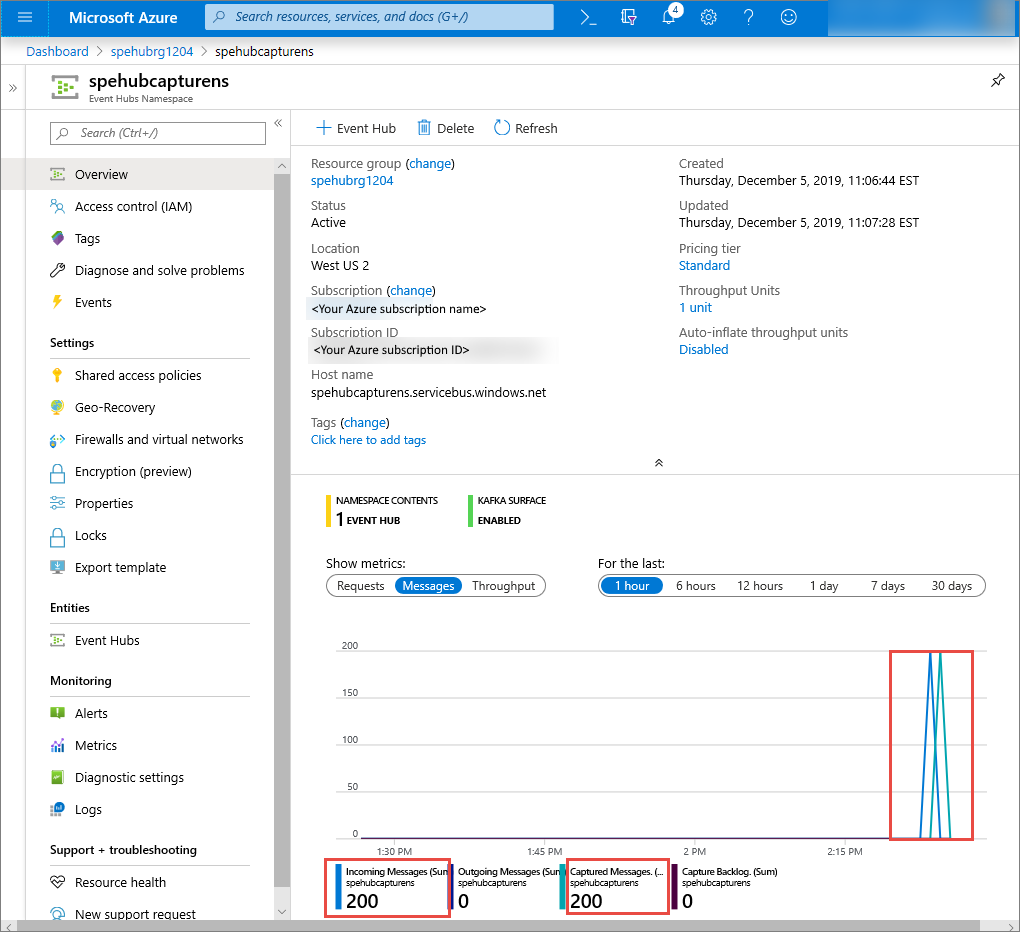快速入门:使用 Python 在 Azure 存储中捕获事件中心数据并读取该数据 (azure-eventhub)
可以配置事件中心,以便在 Azure 存储帐户或 Azure Data Lake Storage Gen 1 或 Gen 2 中捕获发送到事件中心的数据。 本文介绍如何编写 Python 代码,以将事件发送到事件中心,并从 Azure Blob 存储读取捕获的数据。 有关此功能的详细信息,请参阅事件中心捕获功能概述。
本快速入门使用 Azure Python SDK 来演示捕获功能。 sender.py 以 JSON 格式将模拟的环境遥测数据发送到事件中心。 事件中心配置为使用捕获功能将此数据成批地写入到 Blob 存储。 capturereader.py 应用读取这些 Blob,并为每个设备创建一个追加文件。 然后该应用将数据写入 CSV 文件。
在本快速入门中,请执行以下操作:
- 在 Azure 门户中创建 Azure Blob 存储帐户和容器。
- 使用 Azure 门户创建事件中心命名空间。
- 创建已启用捕获功能的事件中心,并将其连接到存储帐户。
- 使用 Python 脚本将数据发送到事件中心。
- 使用另一个 Python 脚本通过事件中心捕获功能读取并处理文件。
先决条件
Python 3.8 或更高版本,装有 pip 且已更新。
Azure 订阅。 如果没有 Azure 订阅,请在开始之前创建一个试用版订阅。
有效的事件中心命名空间和事件中心。 创建事件中心命名空间,并在该命名空间中创建事件中心。 请记下事件中心命名空间的名称、事件中心的名称,以及命名空间的主访问密钥。 若要获取访问密钥,请参阅获取事件中心连接字符串。 默认密钥名称为 RootManageSharedAccessKey。 对于本快速入门,只需获取主密钥。 不需要连接字符串。
Azure 存储帐户、存储帐户中的 Blob 容器,以及存储帐户的连接字符串。 如果没有这些项,请执行以下步骤:
请务必记下连接字符串和容器名称,因为稍后在本快速入门中需要用到。
为事件中心启用捕获功能
为事件中心启用捕获功能。 为此,请按照使用 Azure 门户启用事件中心捕获中的说明操作。 选择在前一步骤中创建的存储帐户和 Blob 容器。 为“输出事件序列化格式”选择“Avro”。
创建用于将事件发送到事件中心的 Python 脚本
在本部分,你将创建一个向事件中心发送 200 个事件(10 个设备 * 20 个事件)的 Python 脚本。 这些事件是以 JSON 格式发送的示例环境读数。
打开常用的 Python 编辑器,如 Visual Studio Code。
创建名为 sender.py的脚本。
将以下代码粘贴到 sender.py 中。
import time import os import uuid import datetime import random import json from azure.eventhub import EventHubProducerClient, EventData # This script simulates the production of events for 10 devices. devices = [] for x in range(0, 10): devices.append(str(uuid.uuid4())) # Create a producer client to produce and publish events to the event hub. producer = EventHubProducerClient.from_connection_string(conn_str="EVENT HUBS NAMESAPCE CONNECTION STRING", eventhub_name="EVENT HUB NAME") for y in range(0,20): # For each device, produce 20 events. event_data_batch = producer.create_batch() # Create a batch. You will add events to the batch later. for dev in devices: # Create a dummy reading. reading = { 'id': dev, 'timestamp': str(datetime.datetime.utcnow()), 'uv': random.random(), 'temperature': random.randint(70, 100), 'humidity': random.randint(70, 100) } s = json.dumps(reading) # Convert the reading into a JSON string. event_data_batch.add(EventData(s)) # Add event data to the batch. producer.send_batch(event_data_batch) # Send the batch of events to the event hub. # Close the producer. producer.close()替换脚本中的以下值:
- 将
EVENT HUBS NAMESPACE CONNECTION STRING替换为事件中心命名空间的连接字符串。 - 将
EVENT HUB NAME替换为事件中心的名称。
- 将
运行脚本以将事件发送到事件中心。
在 Azure 门户中,可以验证事件中心是否已收到消息。 在“指标”部分切换到“消息”视图。 刷新页面以更新图表。 可能需要等待几秒,页面才会显示已收到消息。
创建用于读取捕获文件的 Python 脚本
在此示例中,捕获的数据存储在 Azure Blob 存储中。 本部分中的脚本从 Azure 存储帐户读取捕获的数据文件,并生成可让你轻松打开和查看的 CSV 文件。 你会在应用程序的当前工作目录中看到 10 个文件。 这些文件包含 10 台设备的环境读数。
在 Python 编辑器中,创建名为 capturereader.py 的脚本。 此脚本读取捕获的文件,并为每个设备创建一个文件,用于仅写入该设备的数据。
将以下代码粘贴到 capturereader.py 中。
import os import string import json import uuid import avro.schema from azure.storage.blob import ContainerClient, BlobClient from avro.datafile import DataFileReader, DataFileWriter from avro.io import DatumReader, DatumWriter def processBlob2(filename): reader = DataFileReader(open(filename, 'rb'), DatumReader()) dict = {} for reading in reader: parsed_json = json.loads(reading["Body"]) if not 'id' in parsed_json: return if not parsed_json['id'] in dict: list = [] dict[parsed_json['id']] = list else: list = dict[parsed_json['id']] list.append(parsed_json) reader.close() for device in dict.keys(): filename = os.getcwd() + '\\' + str(device) + '.csv' deviceFile = open(filename, "a") for r in dict[device]: deviceFile.write(", ".join([str(r[x]) for x in r.keys()])+'\n') def startProcessing(): print('Processor started using path: ' + os.getcwd()) # Create a blob container client. container = ContainerClient.from_connection_string("AZURE STORAGE CONNECTION STRING", container_name="BLOB CONTAINER NAME") blob_list = container.list_blobs() # List all the blobs in the container. for blob in blob_list: # Content_length == 508 is an empty file, so process only content_length > 508 (skip empty files). if blob.size > 508: print('Downloaded a non empty blob: ' + blob.name) # Create a blob client for the blob. blob_client = ContainerClient.get_blob_client(container, blob=blob.name) # Construct a file name based on the blob name. cleanName = str.replace(blob.name, '/', '_') cleanName = os.getcwd() + '\\' + cleanName with open(cleanName, "wb+") as my_file: # Open the file to write. Create it if it doesn't exist. my_file.write(blob_client.download_blob().readall()) # Write blob contents into the file. processBlob2(cleanName) # Convert the file into a CSV file. os.remove(cleanName) # Remove the original downloaded file. # Delete the blob from the container after it's read. container.delete_blob(blob.name) startProcessing()请将
AZURE STORAGE CONNECTION STRING替换为 Azure 存储帐户的连接字符串。 在本快速入门中创建的容器的名称为 capture。 如果为该容器使用了不同的名称,请将 capture 替换为存储帐户中容器的名称。
运行脚本
打开其路径中包含 Python 的命令提示符,并运行以下命令,安装 Python 必备组件包:
pip install azure-storage-blob pip install azure-eventhub pip install avro-python3将目录更改为保存 sender.py 和 capturereader.py 的目录,然后运行以下命令:
此命令将启动一个新的 Python 进程,用于运行发送程序。
等待几分钟让捕获运行,然后在原始命令窗口中输入以下命令:
此捕获处理器使用本地目录下载存储帐户和容器中的所有 Blob。 它将处理不为空的文件,并将结果以 CSV 文件的形式写入到本地目录。
